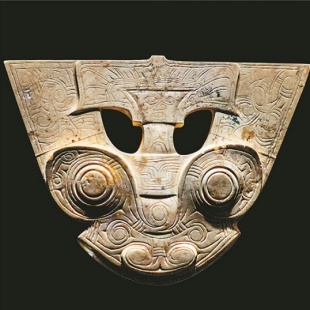Reading between the lines


The Shanghai exhibition includes a wide array of jade animals from the period, including birds, tortoises, a fish and a cicada. The first three may have something to do with animal worship, augury and even the food staple of the Liangzhu people, who literally lived on marshland. The last one, which may or may not be coincidence, later became a crucial part of ancient China's funerary culture and a symbol of virtue.
According to Fang, an arch-shaped jade artifact known as huang has almost only turned up in the tombs of females, and is sometimes accompanied by small jade tubes, which served as the "string" to which huang was attached to form a necklace. Jade spinning wheels and loom fittings, understandably, had also been unearthed exclusively from the burial ground of Liangzhu women.
Likewise, a type of trident-shaped jade is typically found in men's tombs, sometimes with a set of jade awl-shaped objects. They are believed to be headdresses worn together, with the latter spread out like sunrays.
However, jade played its irreplaceable role in Liangzhu society not by being gender-specific, but class-specific. While elite members of society enjoyed their afterlife surrounded by exquisite jade treasures, the burial chambers of their lesser mortals were mostly full of pottery, with the occasional, roughly-made jade awls or tubes.
Through adopting what scholars have dubbed "differential burials" or more generally, "a hierarchical system of jade usage", the Liangzhu people, while reaching the apex of prehistoric Chinese jadeware production, also took their stratified society across the threshold of early statehood.
"At the time, metal mining had yet to develop in this area. As a result, nephrite, or jade as we call it, became the most coveted material whose ownership was indicative of power and status," says Zhou Yun, curator of the Shanghai exhibition. "That's why it was prized over other, more accessible minerals, such as agate."
Titled The Proof of Early China, the exhibition seeks to examine Liangzhu's status as a civilization and its position in the larger concept of Chinese civilization.
"At one time, based on their study of ancient Egypt and Mesopotamia, archaeologists had considered writing (and record-keeping by extension), metallurgy and city-building as the three hallmarks of a civilization. But what about the Maya civilization, which didn't develop metallurgy until very late, in around AD 800, or the Harappan civilization and the Inca civilization?" says Zhou, noting that the latter two, not unlike Liangzhu, didn't develop a writing system. (The Harappan script, also known as the Indus script, is now widely considered by the academic world as constituting a corpus of symbols instead of a written language.)
"Instead, what bound them together as 'civilizations', and set them apart from the various 'cultures' that predated them, are a set of prominent traits including arts and architecture, cities and governments, stratification of society, coupled with a complex division of labor, all of which had characterized the existence of Liangzhu," she continues.





































